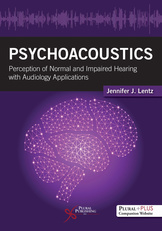Publication
Psychoacoustics
Perception of Normal and Impaired Hearing with Audiology Applications
- Details:
- 238 pages, Illustrated (B/W), Softcover, 7 x 10"
- Included Media:
- Companion Website
- ISBN13:
- 978-1-59756-989-7
- Release Date:
- 11/09/2018
Overview
Psychoacoustics: Perception of Normal and Impaired Hearing with Audiology Applications provides an overview of the field of psychoacoustics, with a primary focus on auditory perception. The influence of hearing loss on these general auditory abilities is discussed in every chapter. Components of the book also include the role of psychoacoustics in audiological assessment and treatment. Psychoacoustics is ideal for graduate students in audiology who intend on having a clinical career and need an understanding of both normal and impaired auditory perception. It is intended to give students sufficient information to understand how the ear achieves auditory perception, what the capabilities of the ear are, and how hearing loss influences that perception. It also provides students with a foundation for further study in the area and to apply psychoacoustic principles to diagnostic audiology and audiological rehabilitation.
Each chapter presents self-contained information related to the acoustics, physiology, and methodologies as they apply to the topic being discussed. Chapters include the following: introduction, relevant acoustics, important physiological studies, perception by normal-hearing listeners, and perception by listeners who have sensorineural hearing loss. The final chapter discusses clinical implications of deficits in perceptual abilities by listeners with sensorineural hearing loss. Because psychoacoustics is intimately integrated into clinical audiology, this chapter also includes a discussion of many of the clinical tests and practices that have evolved directly from psychoacoustic experimentation.
Key Features:
- Learning objectives and summaries begin and end each chapter to convey the goals of the text and review student comprehension.
- Each chapter contains exercises designed to develop critical thinking about psychoacoustics.
- The text emphasizes applied learning for more effective and efficient learning of the material.
- A PluralPlus companion website contains PowerPoint lecture slides, and lab exercises and demonstrations so that students may develop their understanding of psychoacoustic topics and instructors can facilitate that learning.
Reviews
Inyong Choi, PhD, Assistant Professor, Department of Communication Sciences and Disorders, University of Iowa (2018):
"The book contains all essential issues of modern psychoacoustics and hearing sciences. Every chapter provides "take-home points" and "exercises," which will be extremely helpful for both instructors and students. All chapters also discuss sensory neural hearing loss cases, which are unique and helpful for AuD students."Bomjun J. Kwon, PhD, Associate Professor, Department of Hearing, Speech and Language, Gallaudet University (2018):
"This book continually engages students with clinical relevance to the topic of each chapter. Each chapter provides physiological correlates with the given psychoacoustic issues, so that students can have broad knowledge of hearing science."
Introduction
Acknowledgments
Reviewers
Chapter 1. History
Chapter 2. Estimating Threshold in Quiet
Chapter 3. Estimating Thresholds in Noise (Masking)
Chapter 4. Loudness and the Perception of Intensity
Chapter 5. Temporal Processing
Chapter 6. Pitch Perception
Chapter 7. Hearing with Two Ears
Chapter 8. Clinical Implications
Glossary
Index
About The Author
Jennifer J. Lentz received a BS in Biomedical Engineering in 1993 from the University of Iowa and an MS (1996) and PhD (1998) from the University of Pennsylvania in Bioengineering. Her dissertation research involved applying psychoacoustic and modeling techniques to normal auditory perception. She then completed her postdoctoral training at Walter Reed Army Medical Center, where she evaluated auditory perception in listeners with sensorineural hearing loss. In 2002, she began at Indiana University, where she is now a professor and the department chair. She has published numerous articles on the perceptual consequences of sensorineural hearing loss and is currently an editor for the Journal of Speech, Language, and Hearing Research and an associate editor for the Journal of the Acoustical Society of America. In 2014, the Acoustical Society of America elected her to fellow of the society "for contributions on hearing loss and the perception of complex sound."
Related Titles
Translational Perspectives in Auditory Neuroscience
Kelly L. Tremblay, Robert F. Burkard, PhD
488 pages, Color Illustrations (4 Color), Hardcover, 8.5 x 11"
Translational Perspectives in Auditory Neuroscience
Kelly L. Tremblay, Robert F. Burkard, PhD
336 pages, Color Illustrations (4 Color), Hardcover, 8.5 x 11"
Translational Perspectives in Auditory Neuroscience
Kelly L. Tremblay, Robert F. Burkard, PhD
216 pages, Color Illustrations (4 Color), Hardcover, 8.5 x 11"
Purchasers of this book receive complimentary access to supplementary materials hosted on a PluralPlus companion website.
To access the materials, log in to the website using the URL located inside the front cover of your copy of Psychacoustics.
STUDENTS:
To access the student materials, you must register on the companion website and log in using the access code located inside the front cover of your textbook.
INSTRUCTORS:
To access the instructor materials, you must contact Plural Publishing, Inc. to be verified as an instructor and receive your access code.
Email: [email protected]
Tel: 866-758-7251 (toll free) or 858-492-1555












